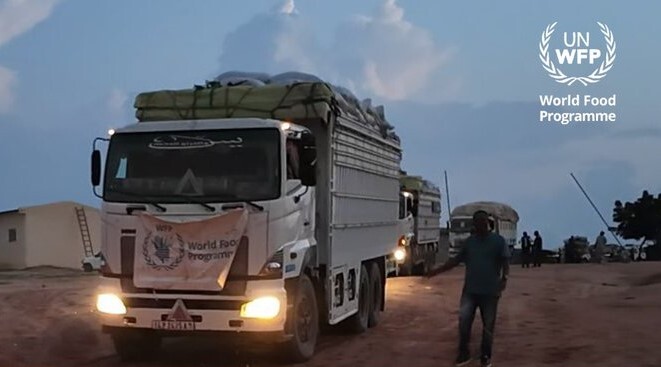38 aid trucks cross Sudan-Chad Adré border

World Food Programme trucks cross the Adré border carrying food and vital aid for people at risk of famine in Darfur (Photo: WFP)
A convoy of 38 aid trucks have crossed the recently re-opened Adré border, a “very important” crossing on the Sudan-Chad border, “distinguished by its proximity to El Geneina, capital of West Darfur,” according to Mohamed El Shabek, a Sudanese expert in humanitarian affairs.
According to a flash update published by UN Office for the Coordination of Humanitarian Affairs (OCHA) in Sudan today, “1,253 tonnes of humanitarian supplies have crossed through the Adré crossing point as of August 26, which will assist about 119,000 people in different locations.”
After the war broke out in mid-April last year, all humanitarian organisations in Central and West Darfur moved to work from Abéché in eastern Chad. The Adré border crossing re-opening was announced on August 15 by the Sudanese government.
According to a statement from UN Secretary-General António Guterres on Saturday, the chairman of Sudan’s Transitional Sovereignty Council and commander-in-chief of the Sudanese Armed Forces (SAF) Lt Gen Abdelfattah El Burhan agreed to facilitate the delivery of supplies into Sudan via the crossing.
The crossing’s proximity to the West Darfur border facilitates the entry of humanitarian aid to the various states of Darfur, where famine has been reported. El Shabek described the opening of the crossing as a major step, as it provides another entry point for aid, in addition to the El Tina crossing in North Darfur, “which was beset by logistical and administrative difficulties.”
Constitutional control
The Sudanese government does not have actual control over the Adré crossing, but rather constitutional control, El Shabek told Radio Dabanga. “This means that the UN cannot cross through Adré without obtaining the approval of the Sudanese government.”
The humanitarian expert ruled out the possibility that the Rapid Support Forces (RSF), which control the Sudanese side of the border, would allow the Port Sudan government to be present on the other side of the border and issue crossing permits. “These measures are not feasible and will not be implemented at all,” he said.
Regarding the procedures issued by the Sudanese Humanitarian Aid Commission (HAC) for crossing the Adré border, related to the inspection of shipments and reporting the source, the carrier, the recipient and the party that will undertake the distribution, El Shabek stressed that “these procedures are inapplicable because the Port Sudan government does not exist in Chad, just as it is not present on the Sudanese side of the border.”
He said the procedures announced by the HAC as “major”. They require, above all, an agreement between the Sudanese de facto government in Port Sudan and the Chadian government in N’Djamena, according to El Shabek.
“Nevertheless, there has been humanitarian aid flowing into Sudan since the announcement of the opening of the crossing. The relief organisations are allowed to enter only through a special permit issued by HAC operating from Port Sudan, which in reality comes down to a procedure similar to officially notifying the government in Port Sudan of the number of trucks that will enter,” he explained. “This is what is currently being implemented, and the government in Port Sudan has no control over anything more than that.”
El Geneina
Humanitarian convoys bound for Darfur and elsewhere in Sudan, especially via the Adré crossing, face the additional challenge of damage to essential infrastructure following unusually heavy rains in Sudan.
The humanitarian expert said that El Geneina has become isolated from the rest of Darfur after some bridges were damaged due to heavy rains. Journalist Mohyieldin Zakaria explained that the floods swept away the Um Duwein Bridge, which connects the east of the city to the west, in addition to the Murnei Bridge, 83 kilometres away on the road linking the cities of El Geneina and Zalingei, in addition to the complete collapse of the old Ardamata Bridge. The new Ardamata Bridge from the eastern and western sides of Wadi Bari also collapsed.
El Shabek expected that the road closures would not last for more than 15 days “because the rainwater is drained naturally.” During this time, aid organisations “may resort to increasing traffic through the El Tina crossing and the Ed Debba route via northern Sudan.”
More than half of the population is facing acute hunger in Sudan, according to UN OCHA. Early August, famine conditions were confirmed in Zamzam camp in North Darfur. “Thousands more are likely to experience similar conditions in 13 other areas at risk of famine,” UN OCHA said this morning.











 and then
and then